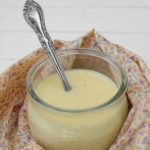
Crème Anglaise
A very nice sauce as it stands or the base for a wide variety of ice creams. Bake it in shallow dishes in a water bath until just set for crème brûlée.
Ingredients
Make the sauce
- 8 each Egg yolks
- 3.33 oz (95 g) Granulated sugar
- .3 each Vanilla bean, split, seeds scraped
- 3.33 oz (95 g) Granulated sugar Yes, twice sugar
- 1/4 t Salt
- 10.66 oz Whole milk
- 10.66 oz Half and half
Tools for the job
- 1 each Wire whisk
- 1 each Wooden spoon
- 1 each Rubber scraper (spatula)
- 1 each Ladle
- 1 4 qt Sauce pan
- 1 each Instant read thermometer
- 1 each Stainless steel bowl
- 1 each Straight sided metal container
- 1 each Fine mesh strainer
- Lots of ice
- 1 each Large pot
Instructions
Make the sauce
-
Combine the half and half, milk, sugar, salt and vanilla pod and beans into a pot. Bring the cream mix to a boil but attend to the pot. Dairy has an unhappy tendency to boil over magnificently making a huge mess, and bad smell and a waste of ingredients. When the cream comes just to the boil, remove the pot, cover or seal with plastic wrap and let stand 20 minutes.
-
When the time has passed, whisk together the egg yolks and sugar in the stainless steel bowl until the egg/sugar turns thick and a lemon yellow color. Ladle 1/2 a cup of the warm milk into the eggs and slowly whisk that into the eggs. Add another half cup, repeat and then add the remaining milk. Whisk well to ensure all the eggs are into the mixture and return everything to the pan with the milk.
-
Place the pan on the burner over medium high heat. Stir with a figure 8 motion inside the pan with the wooden spoon every few stirs, pass the spoon into the sides of the pan. This is the art part of the show. The crème need to be cooked slowly enough to prevent the eggs from curdling, but long enough to make sure they are cooked. That's a fine line. Slow is better than fast here. As the sauce develops a viscosity, the two ways to determine doneness is how the sauce coats the back of the spoon: When you swipe a finger across the back of the sauce covered spoon and the path remains, that is, the sauce does not run into the vacated space, it is almost certainly done. The other method, which is a bit more reliable, is to use the thermometer. Cook the sauce to 180 degrees F. Because the mass of sauce will retain heat, it will continue to increase in temperature even when off the heat. This is where the organization matters.
-
Strain the sauce into the straight sided metal container and place that into the sauce pan with ice and add a few cups of water to make the small pan immersed in the ice. Stir the sauce slowly to make sure it is all getting exposed to the cold sides and bringing the temperature down. Also watch the the melting ice doesn't cause the sauce container to tip over into the ice. Trust me, that is not an emotion you want to fell. Trust me.
-
When the sauce is cool to the touch, drink it all. No don't; I kid. Cover with plastic wrap and store in the cooler until fully chilled.
Recipe Notes
Much of the art of making crème Anglaise is in the seeing. This video does a very good job of showing and explaining the techniques in the process.
In addition to or in place of the vanilla (What!?) steep herb stems such as mint or thyme or lavender with the milk. You can add spices such as cardamom pods or saffron for a special touch.